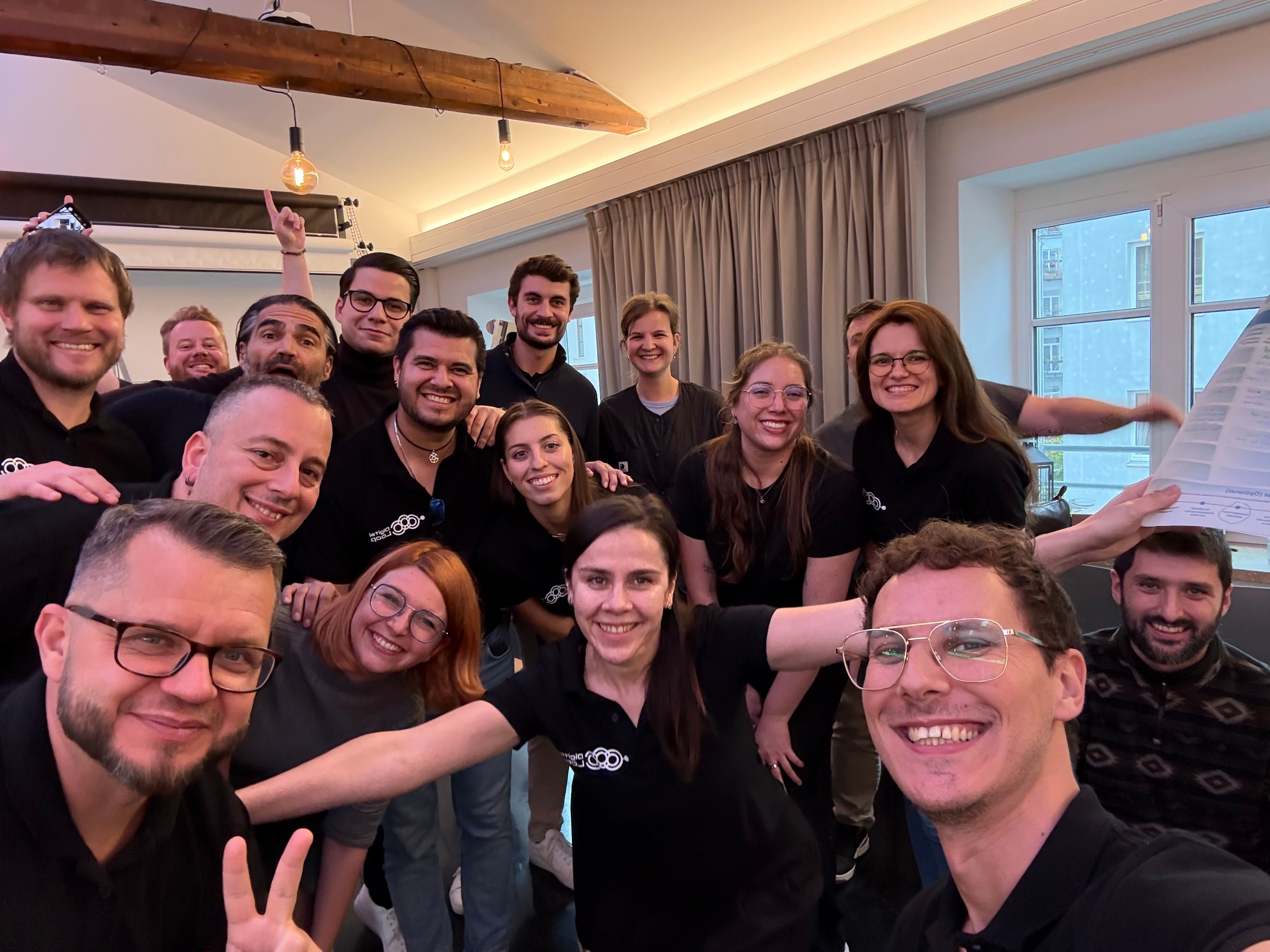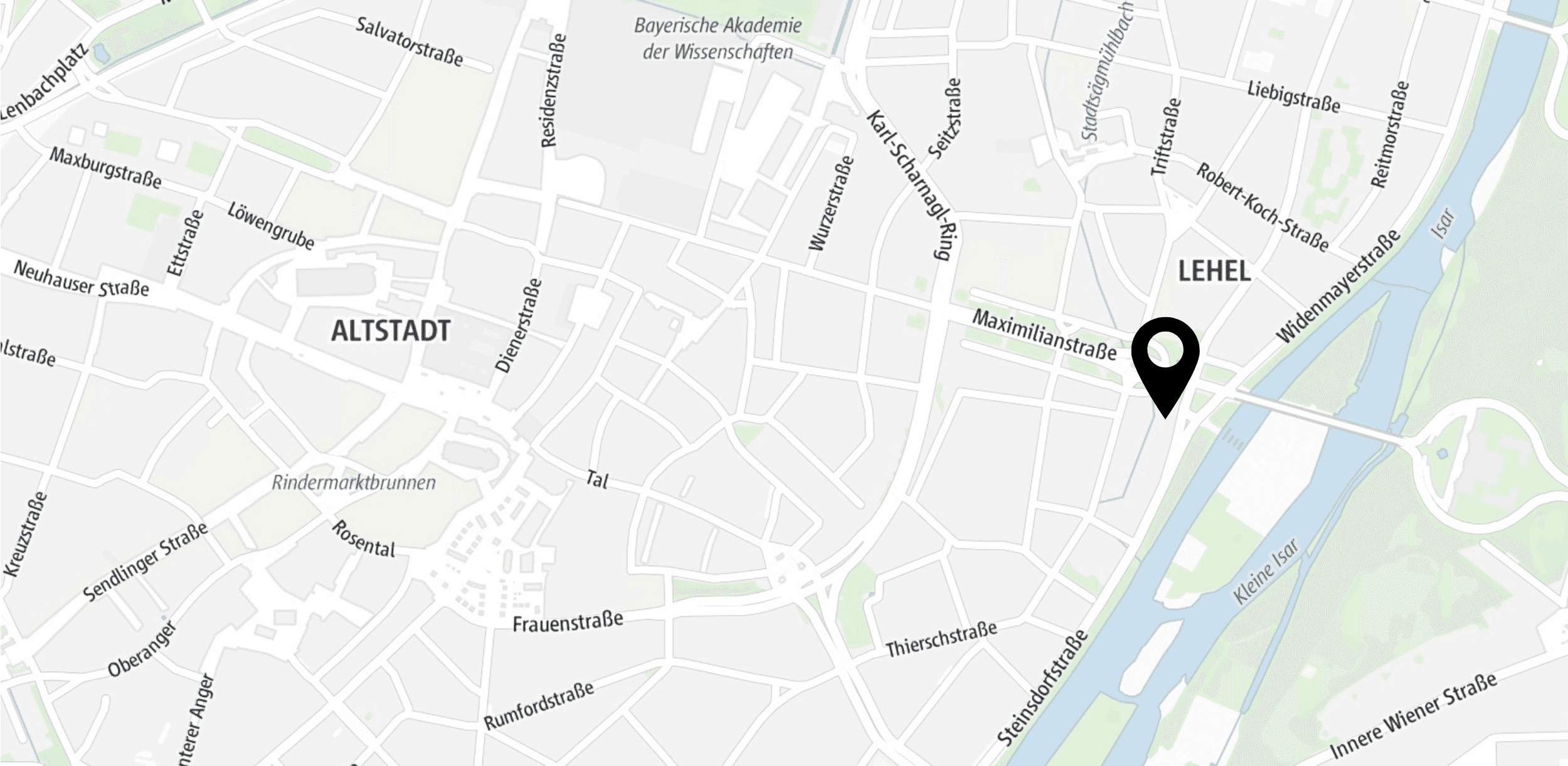Let’s be honest - being a marketer today means managing a wide range of tasks, from drafting compelling emails and generating engaging content to launching campaigns, optimizing performance, and analyzing campaign results to make data-driven decisions. And while your marketing to-do list keeps growing, your hours in the day don’t. That's where Generative AI (GenAI) can support you in creating high-quality content or automating repetitive tasks. This enables you to be more efficient and allocate more time to strategic growth and impactful results.
AI tools or agents are now capable of writing, designing, summarizing, analyzing, brainstorming, and even automating repetitive tasks. You can develop 30 AI agents to perform various tasks, and they will operate 24/7 without requiring a salary. Of course, there are subscription, development, and maintenance costs, but that should be a fraction of the monthly salary of 30 employees.
Today, we have put together a list of the 11 most trending AI tools that can help marketers like you become more efficient, focused on growth, and adapt to upcoming changes. Later, we will also discuss three successful case studies of GenAI technology that will help you understand how rapidly AI is evolving.
So, are you ready to discover which GenAI tools can supercharge your next marketing campaign? Let’s dive in.
The 11 most trending GenAI tools with their Pros and Cons
1. Google AI Overview

Google AI Overview, or AIO in short, was officially rolled out in May 2024 in the US market and in March 2025 in the EU market. This is more like an extended Search Engine Result Page (SERP) that provides a summarized answer to the query or information you search for. This usually works for the informational keywords. It usually appears at the top of SERP, just below the sponsored ads. There is no guarantee that Google will always show you a summarized AI Overview answer for all queries. Sometimes it appears, and sometimes it displays traditional search results.
Pros:
- Provide a summarized answer, and therefore, you do not need to scroll and check 10-15 links to find the desired information.
- Combining insights from several web sources
- Can handle complex, multi-step questions effectively
- A great tool, especially for students and researchers, to quickly find an overview of their inquiries.
Cons:
- It is not interactive, and therefore, you can not ask follow-up questions.
- The overview always comes with a conclusion. So, it's either a hit or a miss.
- May generate incorrect or misleading content
- Might not cite the most authoritative or varied sources, as you are not in control
- It significantly reduces the number of clicks for publishers, which may not be motivating for them to produce high-quality content in the future.
- Sometimes it can oversimplify the query and give a result without considering the context or details.
- Can not answer a query that requires critical thinking.
2. Google AI Mode
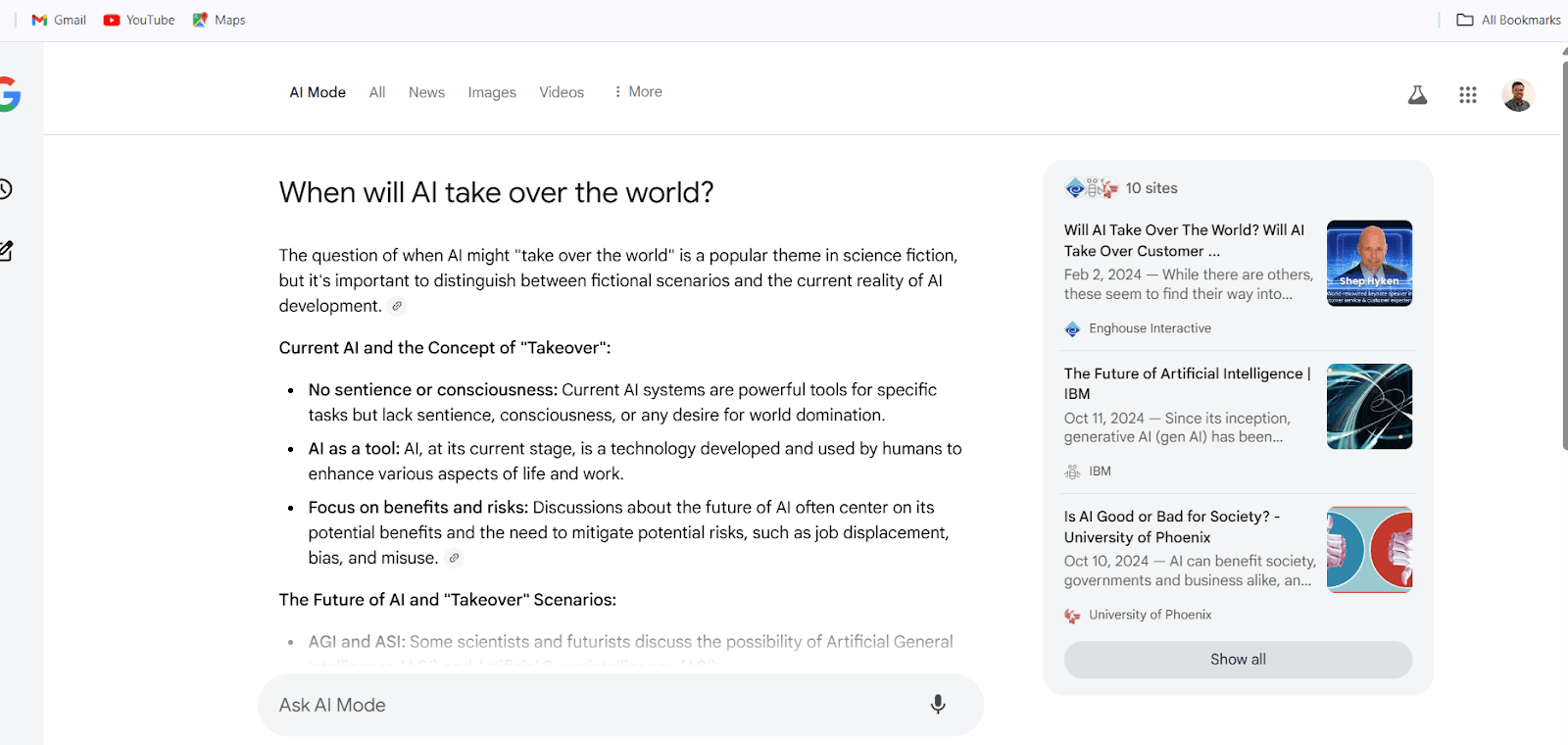
Google AI Mode is a comprehensive search solution that addresses many aspects lacking in the AI Overview. Google started rolling out the AI Mode SERP feature to a limited number of US users in May 2025, upon request. This means users need to register first, and they can only test the feature when they get access. The tools have not been rolled out yet in the EU market (July 2025).
AI Mode provides more in-depth results powered by deep research compared to AI Overview. While AI Overview tends to replace the existing source, the answer may not be accurate. However, AI Mode aims to provide a logical explanation that actually makes sense. Google still attempts to follow the typical ChatGPT answer format, which consists of an introduction and a conclusion, but some questions do not need a conclusion. They can also be open-ended. So, the result can still be a hit and a miss. In this case, visitors may check some citations.
Pros:
- Google AI Mode is capable of providing more comprehensive multi-part results for complex questions.
- It allows users to ask follow-up questions and remember the context while replying.
- It also provides a list of valid citations to support the authenticity of the result.
- It can create a persona of you, track previous activities, and provide a personal answer to the questions you ask.
- Offers a distinct AI experience, similar to other popular AI search engines like ChatGPT or Perplexity AI.
Cons:
- AI Mode is still restricted and not available for all users in all regions.
- AI Mode is superior to AI Overview in many aspects, but our tests have revealed that it still occasionally produces incorrect results.
- It further intensifies challenges for publishers to optimize their content for AI summarization.
3. ChatGPT by OpenAI
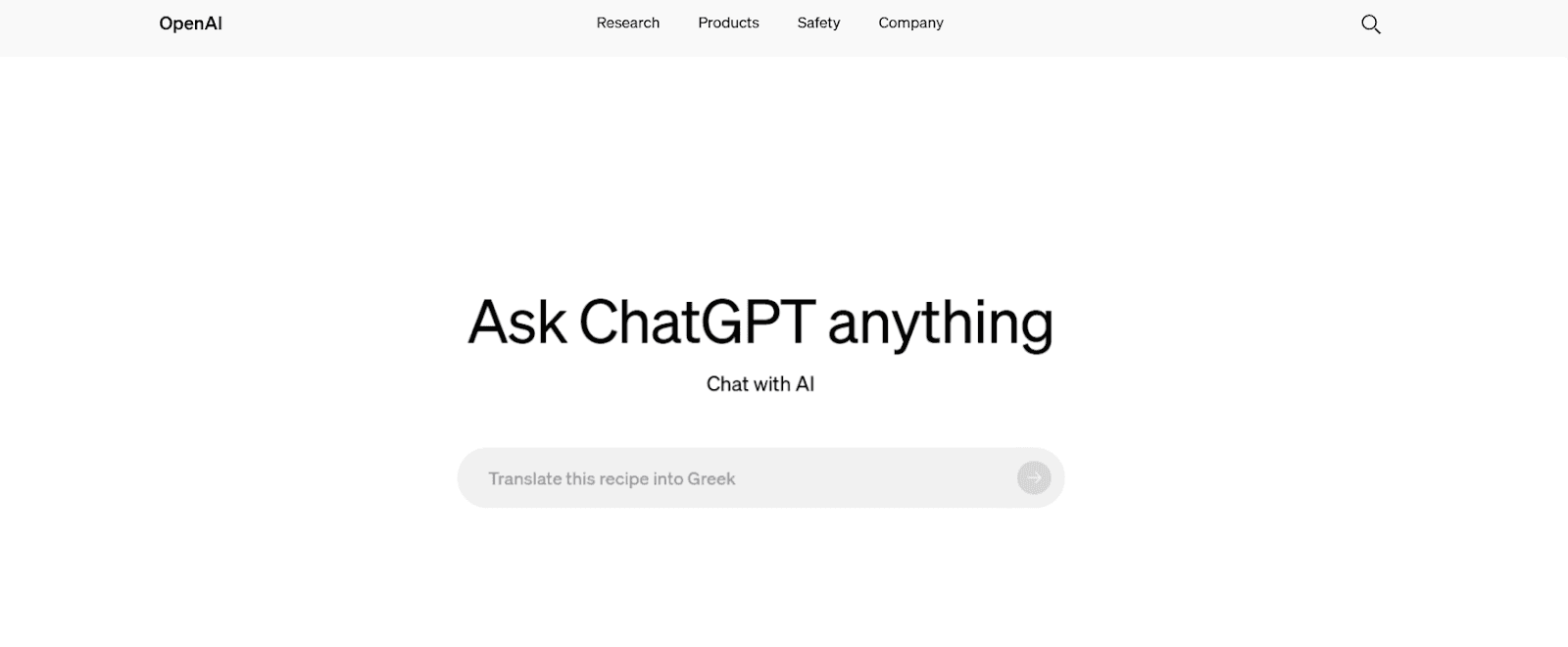
When you think about the transformation of content creation, what comes to your mind first? I am not a magician, but I can still say it is ChatGPT. In fact, ChatGPT, brought to us by OpenAI, is the pioneer of the GenAI application in content production. ChatGPT can be the go-to GenAI tool whenever you want to generate human-like, engaging content or analyze structured or unstructured data.
OpenAI has also recently launched SearchGPT, which can provide updated information with valid sources. This is significant because users have been complaining for a while that ChatGPT shows fake information. Besides, with ChatGPT, OpenAI is moving another step to establish a new search engine powered by generative AI:
Pros:
- Highly flexible and effective for various content types, including blog posts, emails, social media posts, and reviews.
- Capable of real-time customer interaction for chatbots.
- Easy to integrate into marketing workflows with APIs.
- Can perform complicated data analysis tasks
- Capable of generating a graphic image
Cons:
- Requires clear prompts to create high-quality output.
- Limited by its training data, which might miss some less popular niches or updated topics.
- Generating graphic images is more like a hit-or-miss process
- The use of repetitive phrases and over-the-top words is a significant concern
- Sometimes, ChatGPT makes up fake statistics/information
4. Scale AI
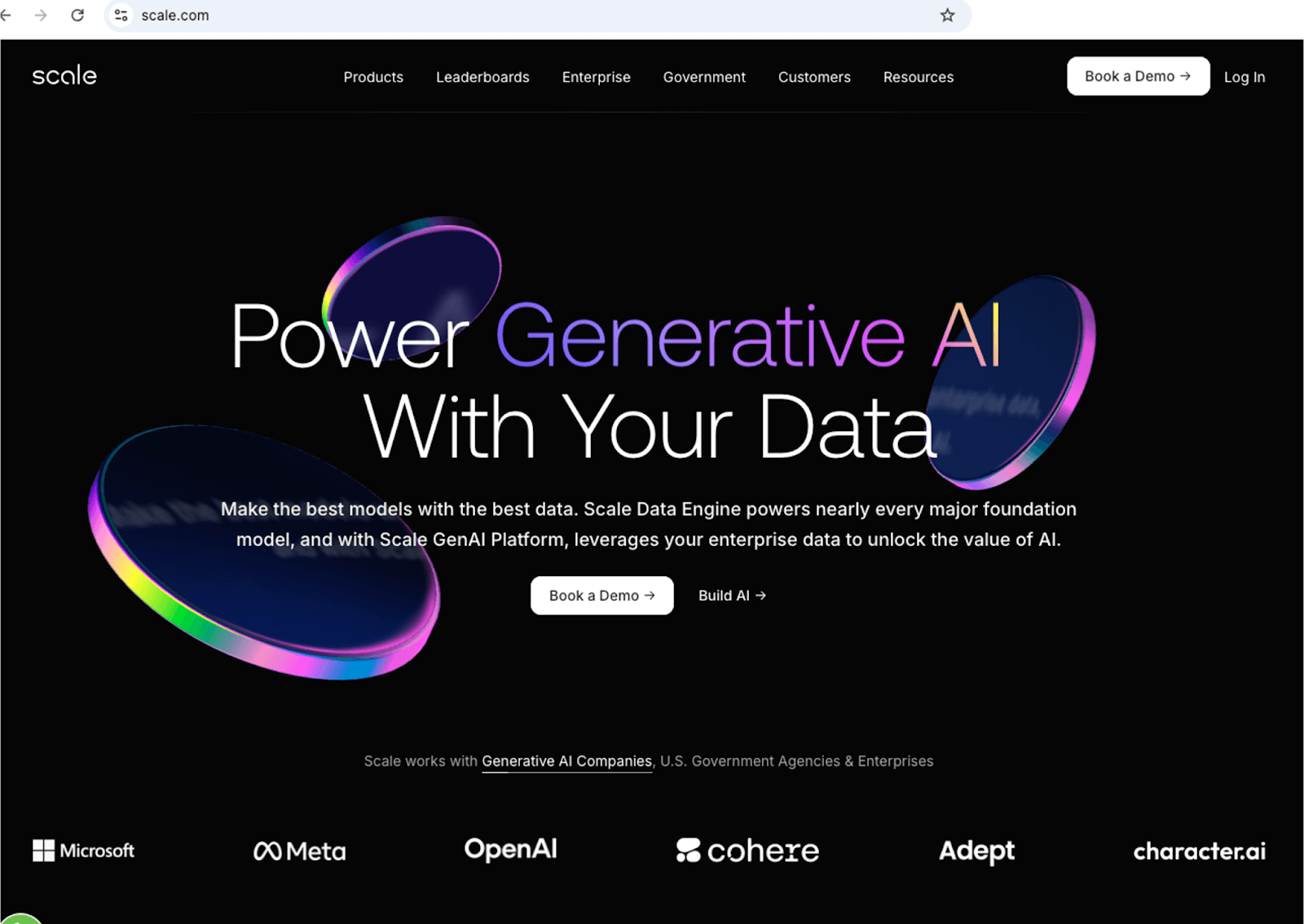
Scale AI, which was acquired by Meta in June 2025 for $14.3 billion, is a U.S.-based artificial intelligence company founded by Alexandr Wang and Lucy Guo. It is a B2B enterprise solution and specializes in data annotation, model evaluation, and infrastructure for training and deploying other B2B and B2C AI models. Initially, it focused on data labeling for self-driving cars, but now offers a wide range of solutions, including, but not limited to, model evaluation, synthetic data generation, AI-driven data labeling tools, and Reinforcement Learning with Human Feedback (RLHF).
Pros:
- High precision across complex domains like autonomous driving, defense, medical imaging, and more.
- Perfect for large enterprises as they have already onboarded Google, Microsoft, OpenAI, Meta, Cohere, Cisco, and many more.
- Provides RLHF data for big models and ensures higher output accuracy.
- Helps enterprises to scale their own foundation models.
- Supports human-in-the-loop pipelines, multimodal tasks, and real-time evaluation.
- Safe for confidential datasets, and therefore, the government and defense sectors also use it.
Cons:
- Designed primarily for enterprises, pricing and access may be prohibitive for startups.
- Comparatively difficult to set up and may require a team of machine learning engineers, infrastructure engineers, data scientists, and other specialists.
- Pricing is not transparent.
5. Perplexity AI
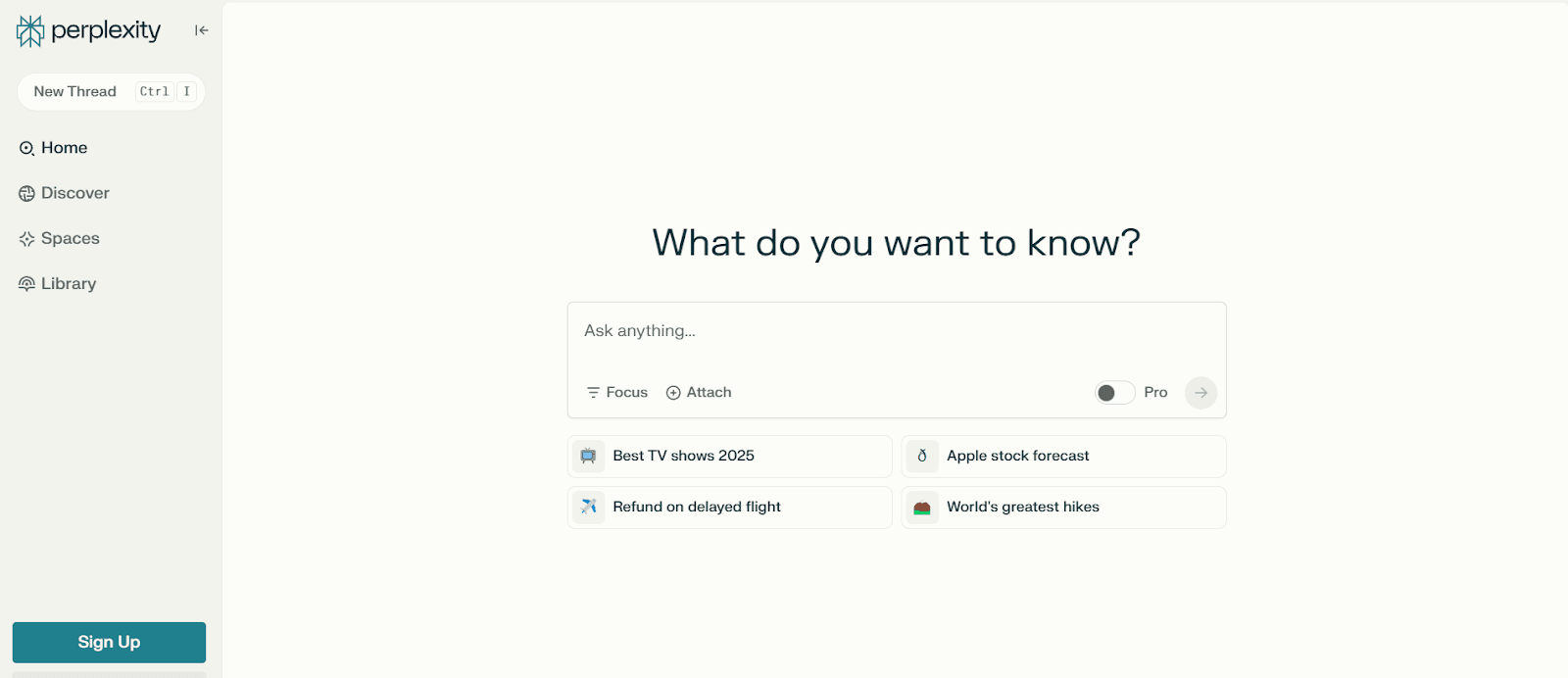
Imagine a search engine that doesn’t just throw links at you but delivers clear, conversational answers with the sources to back them up. That’s Perplexity AI, an innovative tool that blends the best of conversational AI and factual accuracy. We conducted multiple experiments with Perplexity AI and can confirm that it is far ahead of the newly launched SearchGPT. It can provide excellent results for local searches, which SearchGPT still lacks.
Pros:
- Provides relevant, concise, and human-like responses
- Add sources to make sure the information is reliable.
- Cover a wide range of industries, from tech and research to lifestyle queries.
- Provide up-to-date information
- Good for local searches
Cons:
- Heavily relies on external data sources
- Sometimes, it hallucinates and can not handle complicated questions well.
- Still in the learning phase
6. Jasper.ai
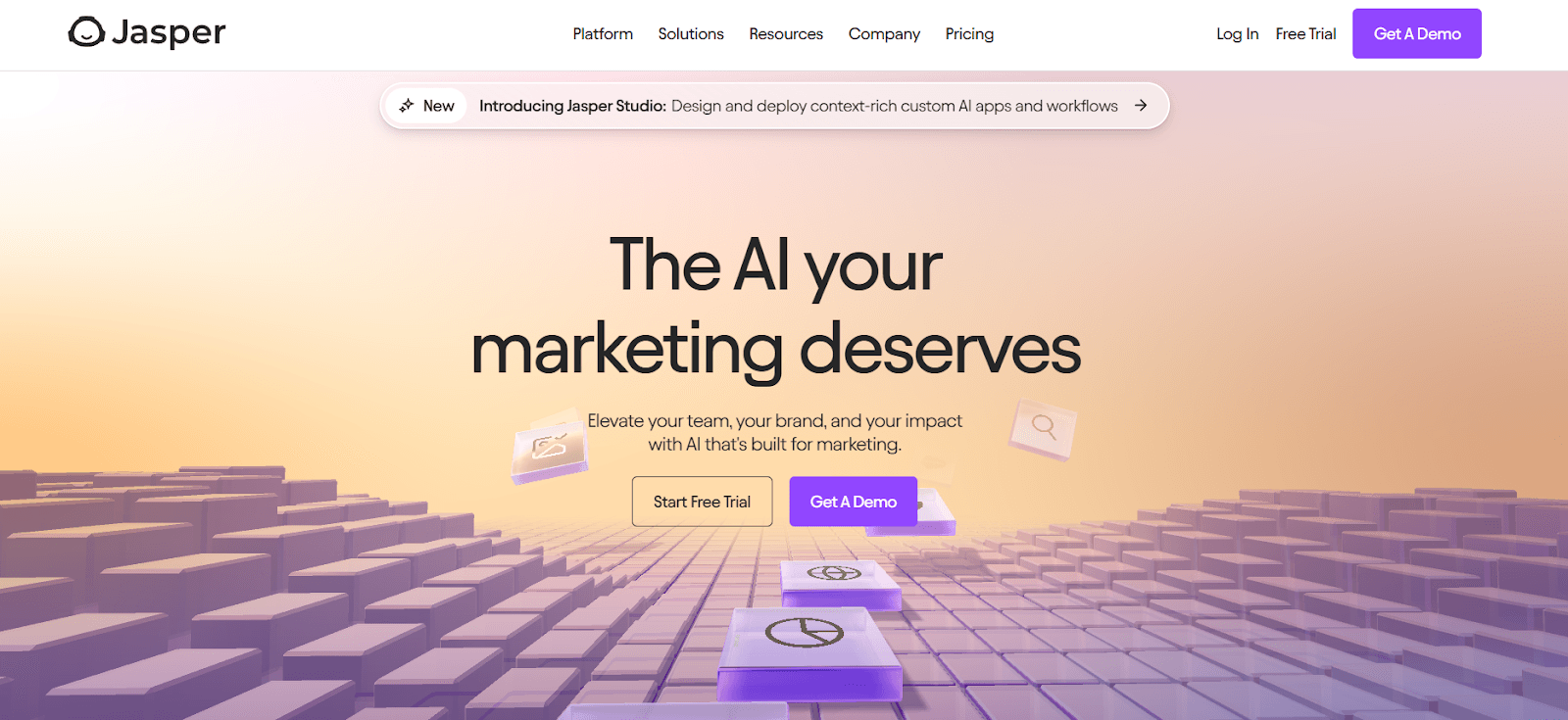
This list would be incomplete without mentioning Jasper AI, formerly known as Jarvis AI, a content-writing tool specially designed for marketers. They started the journey even before ChatGPT in 2021 and created a huge buzz among SEO professionals by supporting them to produce high-quality SEO-optimized content with some simple prompts. Over time, the tools have matured and now can produce human-like content focusing on marketing.
Pros:
- Jasper.ai is imagined and built for marketers
- Comes with different templates for different marketing needs.
- Can optimize content following your brand voice.
- Good for long-form content
- Offers a collaboration feature for multiple team members.
Cons:
- Higher price compared to its renowned competitors, such as ChatGPT
- Confined to only text-based content and not renowned for producing other forms of content, such as graphic image generation.
7. Adobe Firefly
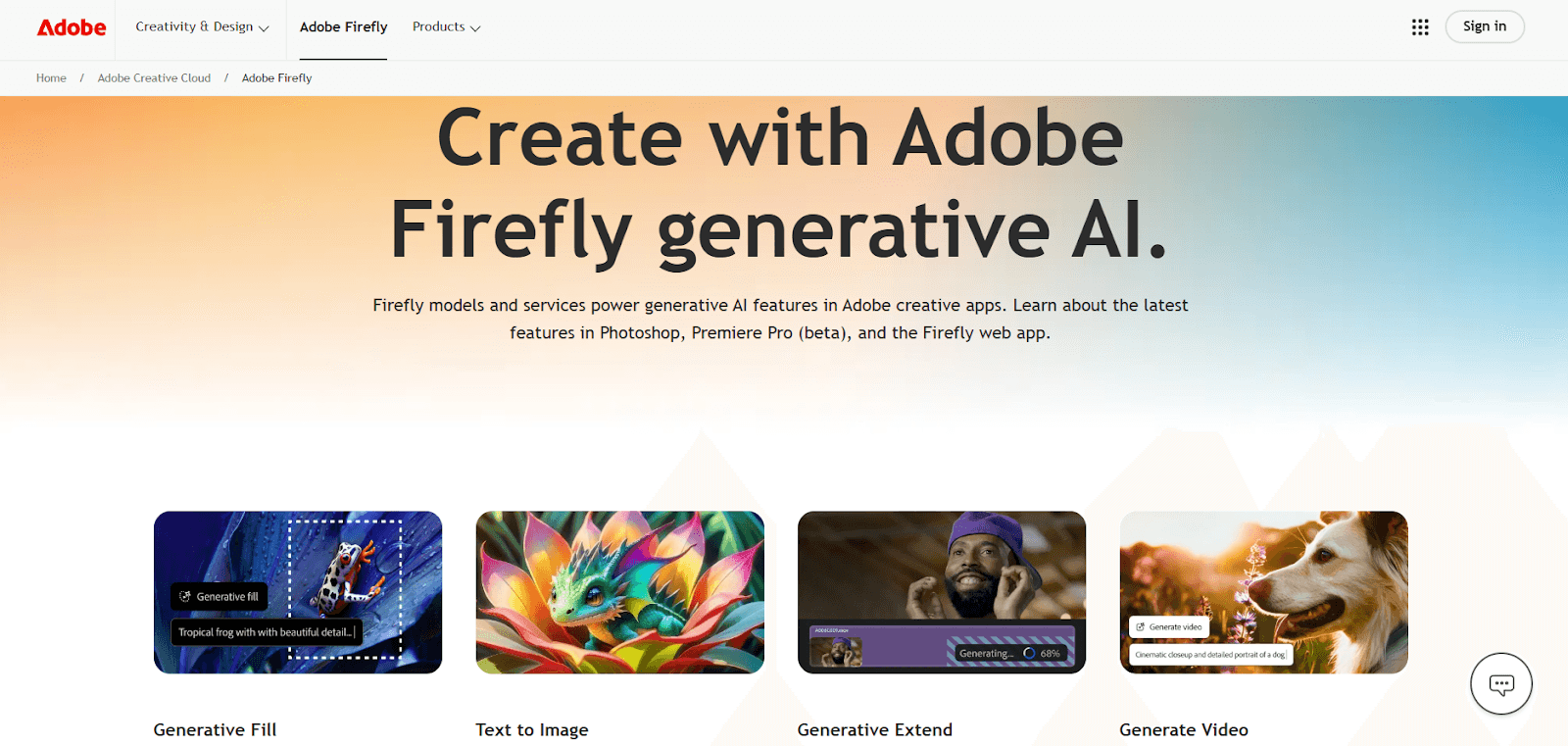
Adobe Firefly is one of the most promising visual generation tools in the current market. It offers four features: text-to-image, generative fill, generative extend, and generate video. The best part is that the generative fill and generative extend are already integrated with Adobe products. For example, you can alter or extend an image using Adobe Photoshop’s generative fill or generative extend options.
Pros:
- Integrated with Adobe Creative Suite for all users
- Produce high-quality output that can be used for professional use cases.
- The interface is user-friendly.
- Less ethical and copyright infringement concerns since Adobe prefers to use licensed and user-contributed datasets for training
Cons:
- Beginners may struggle initially to generate high-quality output as there is a learning curve.
- A Creative Cloud subscription is necessary to use the features.
8. Midjourney

After ChatGPT, Midjourney disrupted the content generation process like a storm. Users were fascinated to experience the first GenAI-generated high-quality images and graphics for free. The tool can create stunning visual content, which makes it an excellent tool for social media management and other marketing activities.
Pros:
- Generate high-quality visuals based on the given prompts.
- Can imitate an existing photo and create more versions following the instructions.
- No design experience is needed to produce creative arts and graphics.
Cons:
- Limited to only image and art generation.
- Discord is used as a medium to give the necessary access.
9. Anyword
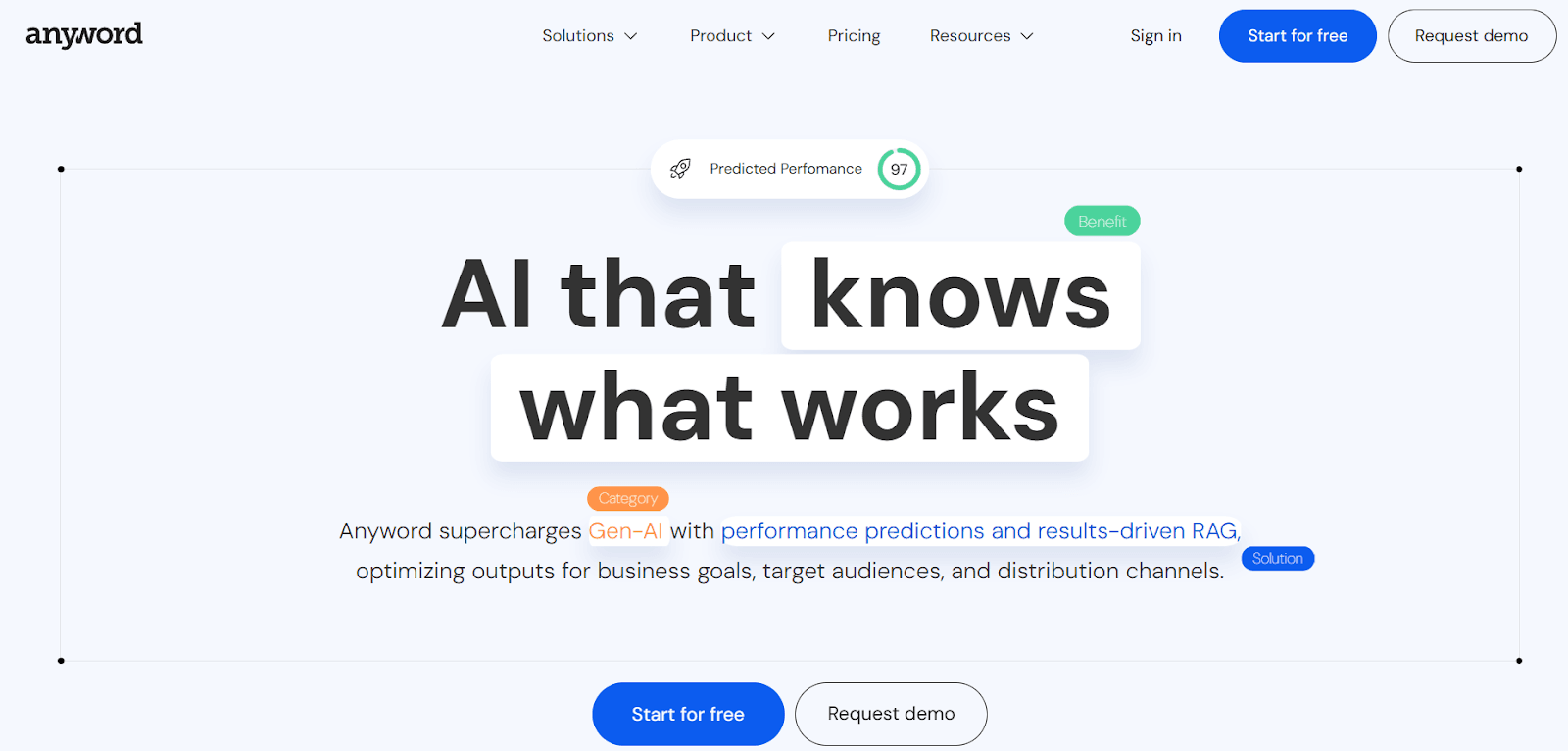
Anyword is another GenAI-powered content generation tool that assures a higher conversion rate. The difference between ChatGPT and Anyword is that ChatGPT is designed to be an all-around short-form content generation tool, while Anyword is designed to predict and write content to launch successful marketing campaigns.
Pros:
- Focuses on the business result, not generating texts
- Great fit for commercial tasks such as ad copy, landing pages, and email marketing.
- The interface is super user-friendly
Cons:
- Like Jasper, Anyword lacks in terms of non-text content creation
- In our experiment, some output looked formulaic
10. Canva’s AI Tools
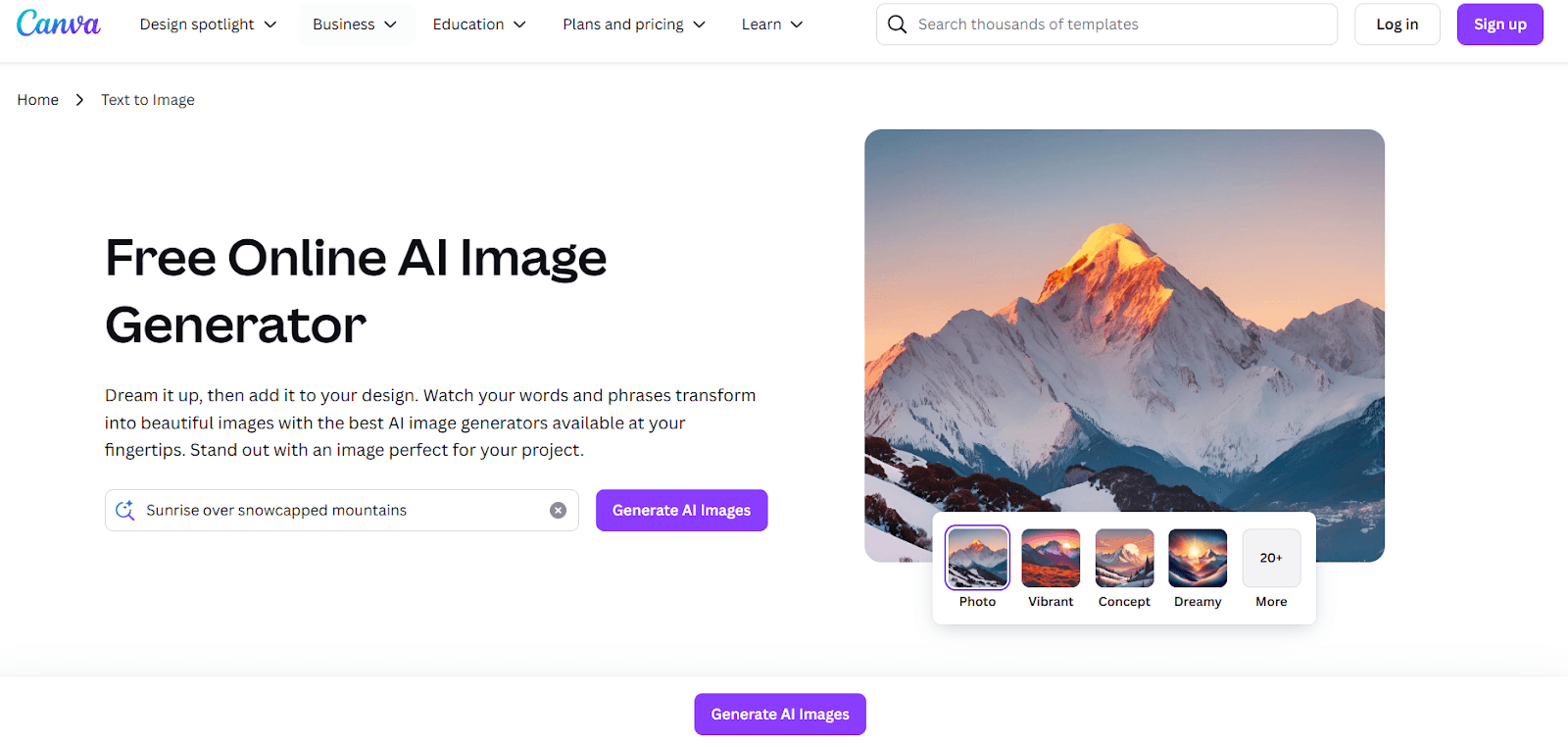
We have all probably used Canva for graphic design purposes. With the power of GenAI, Canva is now easier to use and more accessible, enabling marketing professionals to generate creative graphic elements within a minute.
Pros:
- The interface is super user-friendly and offers drag-and-drop functionality.
- AI-powered design suggestions
- Cheaper compared to other renowned tools.
- Enables non-designers to generate and edit graphic images within a few minutes.
Cons:
- It is not suitable for professionals because of its limited flexibility and lack of advanced design options.
- Sometimes, designs have limited customization options.
- There is a learning curve for beginners.
11. ActiveCampaign
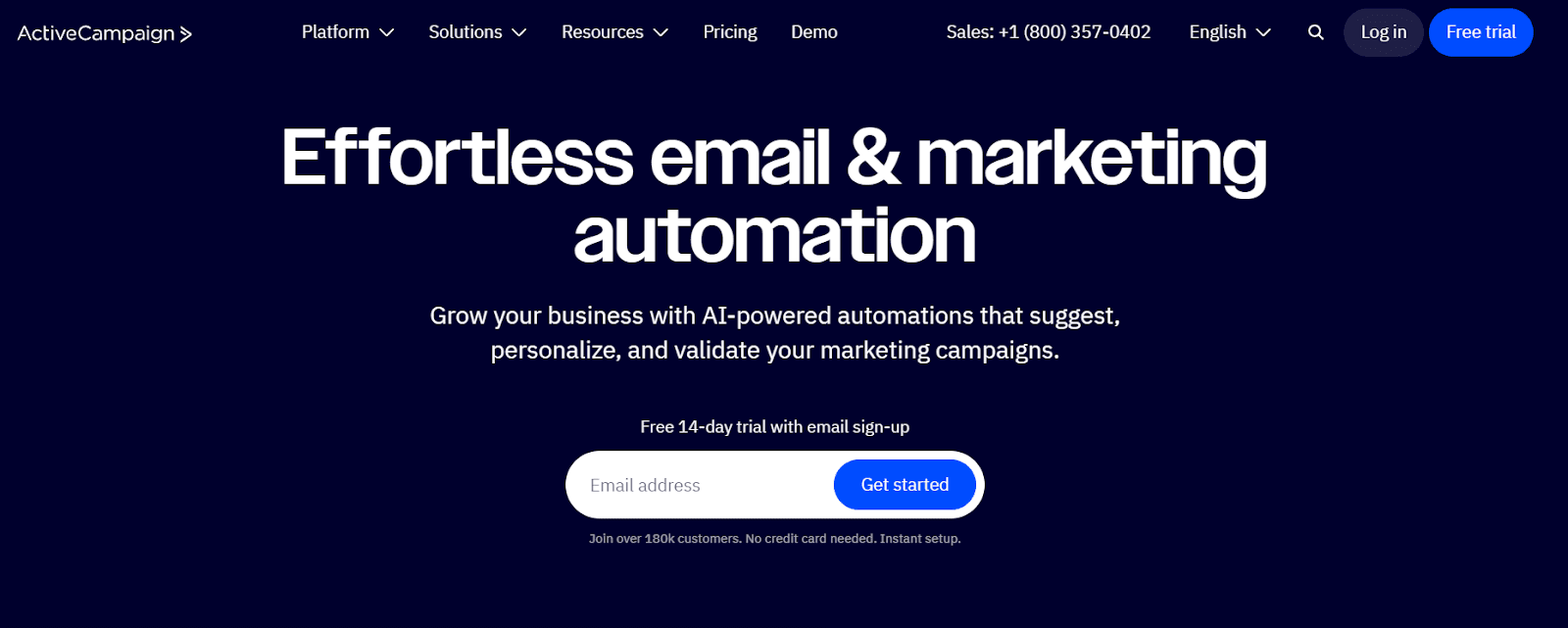
ActiveCampaign is one of the most reliable marketing platforms with AI-powered features for email campaigns and marketing automation. It is more like a 360-degree solution and helps marketers write marketing copy, design landing pages, launch marketing campaigns, conduct A/B tests, and check analytics.
Pros:
- Combines AI with automation to execute advanced workflows.
- User-friendly and has a reliable online community.
- Super helpful for customer segmentation and personalization.
- Has analytics and reporting features.
Cons:
- It can be overwhelming for new users.
- Automation is the core product, and content generation comes as the secondary product.
- Does not offer any free plan.
Successful Implementation of GenAI and Challenges
Viral Generative AI projects/Campaigns
Hundreds of companies are now trying to leverage the power of GenAI technology to boost their business. We will talk about three case studies today to showcase the successful implementation of GenAI technologies in marketing campaigns and business. These case studies are a personalized advertising campaign by Zomato, a GenAI-powered trip planner by Booking.com, and a personalized styling service by Stitch Fix.
Case Study 1: Personalized Advertising Campaign by Zomato

In 2022, the leading Indian food delivery platform Zomato launched a highly personalized ad campaign with the famous Bollywood actor Hrithik Roshan. The actor talked about specific dishes from specific restaurants in the ad, and both the dishes and the restaurants vary from viewer to viewer based on their location and preferred dishes. Gen AI localized these ads by leveraging deep fake technologies.
The GenAI model was trained with around a 30-minute monologue presented by the actor. Gradually, the GenAI model learned how the actor talks and gives facial expressions, and later, the speech output was changed to match the viewer's location and food preference. For example, if a viewer watches an ad from Kolkata, India, the actor will say that he is craving a burger from Social Kitchen, a famous local restaurant. The result of this ad campaign was impressive. It significantly increased engagement, sales, and social media buzz.
Case Study 2: GenAI Trip Planner by Booking.com

According to recent research, around 69% of US travelers prefer to book their trips early, but 57% of them start planning their tours without knowing the destination and accommodation. To make the booking process easier, Booking.com launched 'AI Trip Planner', powered by GenAI, in 2023.
First, users need to inform the tour planner chatbot about their preferences, interests, and destination choices. Then, it removes any personal data and generates personalized recommendations in a carousel format by leveraging Booking.com's extensive database. The carousel format allows users to browse and check all the available options easily.
Diverse datasets of reviews and travel information from the booking.com database have been used to train the GenAI models. The chatbot is well-trained and, therefore, can answer general travel-related questions, just like a human assistant. Personalized itinerary creation is another feature it can offer for a specific city, region, or destination, considering individual requirements.
Case Study 3: Personalized styling service by Stitch Fix

Stitch Fix is another good example of using GenAI to provide personalized solutions. Stitch Fix has combined its deep-learning technology with the large language models provided by OpenAI. They first collect information/feedback from the customer, process it using GenAI technologies, and finally provide personalized recommendations.
They also developed the Outfit Creation Model (OCM), which is capable of creating millions of new outfit combinations. The OCM model used GenAI technology and was trained by customers' previous purchases and existing outfits from Stitch Fix's inventory. The technology shows visitors how an item they are interested in will look alongside other items they have purchased before or plan to purchase.
If you want to read more about the recent update on AI and GenAI, please visit our AI Blog section. In case you desire to know how Digital Loop can help you redefine your presence in Google AI Overview, Google AI Mode, and other GenAI search platforms, please check our GAIO service page.







